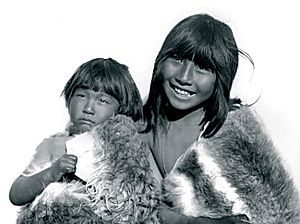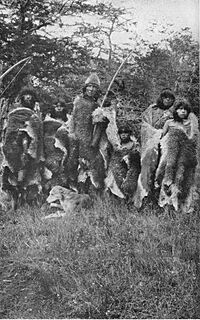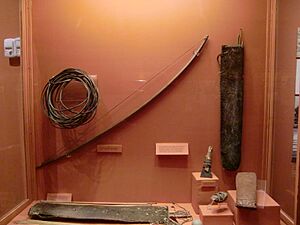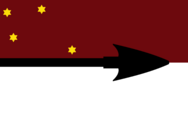Selk'nam people facts for kids

Selk'nam children, 1898
|
|
| Total population | |
|---|---|
| 2,761 (Argentina, 2010 est.) 1,144 (Chile, 2017) |
|
| Regions with significant populations | |
| Argentina and Chile (294 in Tierra del Fuego). At least 11 live in United States |
|
| Languages | |
| Spanish, formerly Selk'nam (Ona), One speaker in Chile. |
|
| Religion | |
| Animism, Christianity | |
| Related ethnic groups | |
| Haush, Tehuelche, Teushen |
The Selk'nam, also known as the Onawo or Ona people, are an indigenous people in the Patagonian region of southern Argentina and Chile, including the Tierra del Fuego islands. They were one of the last native groups in South America to be encountered by migrant Europeans in the late 19th century. In the mid-19th century, there were about 4,000 Selk'nam; in 1916 Charles W. Furlong estimated there were about 800 Selk'nam living in Tierra del Fuego; with Walter Gardini stating that by 1919 there were 279, and by 1930 just over 100.
Until 2020, they were considered extinct as a tribe in Chile, and much of the English language literature. Settlement, gold mining and farming in the region of Tierra del Fuego were followed by the Selk'nam genocide.
While the Selk'nam are closely associated with living in the northeastern area of Tierra del Fuego archipelago, they are believed to have originated as a people on the mainland. Thousands of years ago, they migrated by canoe across the Strait of Magellan. Their territory in the early Holocene probably ranged as far as the Cerro Benítez area of the Cerro Toro mountain range in Chile.
Contents
History
Traditionally, the Selk'nam were nomadic people who relied on hunting for survival, though they were also recorded as engaging in occasional fishing during low tides. They dressed sparingly despite the cold climate of Patagonia. They shared Tierra del Fuego with the Haush (Manek'enk), another related nomadic culture who lived in the south-eastern part of the island, and the Yahgan (Yámana), an unrelated group who could be found along the southern coast.
Relations with Europeans
In late 1599, a small Dutch fleet led by Olivier van Noort entered the Strait of Magellan and had a hostile encounter with Selk'nam which left about forty Selk'nam dead. It was the bloodiest recorded event in the strait until then.
James Cook described meeting a people in Tierra del Fuego in 1769 that used pieces of glass in their arrowheads. Cook believed the glass had been a gift from the French explorer Louis Antoine de Bougainville, indicating potentially several early contacts. Glass arrowheads became an ever more common occurrence among the Selk'nam as their interactions with Europeans became more common.
The Selk'nam had little contact with ethnic Europeans until settlers arrived in the late 19th century. These newcomers developed a great part of the land of Tierra del Fuego as large estancias (ranches), depriving the natives of their ancestral hunting areas. The Selk'nam, who did not have a concept of private property, considered the sheep herds to be game and hunted the sheep. The ranch owners regarded this as poaching, and paid armed groups or militia to hunt down and kill the Selk'nam, in what is now called the Selk'nam genocide.
Salesian missionaries worked to protect and preserve Selk'nam culture. Father José María Beauvoir explored the region and studied the native Patagonian cultures and languages between 1881 and 1924. He compiled a 4,000-word vocabulary of the Selk'nam language, and 1,400 phrases and sentences, which was published in 1915. He included a comparative list of 150 Selk'nam-Tehuelche words, as he believed that there were connections to the Tehuelche people and language to the north. German anthropologist Robert Lehmann-Nitsche published the first scholarly studies of the Selk'nam, although he was later criticized for having studied members of the Selk'nam people who had been abducted and were exhibited in circuses.
A common comment about the Selk'nam from Europeans was on their height, where in early records they were recorded as "giants", with the ethnographer Frederick Cook writing in 1897–1899 that their average height was six foot, with instances of individuals six and a half foot tall.
Relations with Europeans in the Beagle Channel area in the southern area of the island of Tierra del Fuego were somewhat more cordial than with the ranchers. Thomas Bridges, who had been an Anglican missionary at Ushuaia, retired from that service. He was given a large land grant by the Argentine government, where he founded Estancia Harberton. Lucas Bridges, one of his three sons, did much to help the local cultures. Like his father, he learned the languages of the various groups and tried to provide the natives with some space in which to live their customary lives as "lords of their own land." However the forces of change were against the indigenous tribes, who continued to have high fatality rates as their cultures were disrupted. Lucas Bridges' book, Uttermost Part of the Earth (1948), provides sympathetic insight into the lives of the Selk'nam and Yahgan. In recording the stories of a multitude of Europeans living in Tierra del Fuego, the journalist John Randolph Spears wrote that:
It is plain that the Ona is an aggressive warrior toward the whites only because of ill-treatment. […] Damnable ill-treatment on the part of the whites is at the bottom of all the Ona aggressiveness – and Ona suffering.
Selk'nam genocide
The Selk'nam genocide was the genocide of the Selk'nam people from the second half of the 19th to the early 20th century. The genocide spanned a period of between ten and fifteen years. The Selk'nam had an estimated population of 4,000 people around the 1880s but saw their numbers reduced to 500 by the early 1900s.
In 1879, the presence of significant gold deposits in the sands of the main rivers of Tierra del Fuego were reported. Hundreds of colonialists and foreign newcomers came to the island in search of fortune, conflicting with the indigenous population. However, resources of the metal depleted rapidly.
Ranching became the center of controversy in the Magellanic colony. The colonial authorities were aware of the indigenous group's plight, but sided with the ranchers' cause over the Selk'nam, who were excluded from their worldview based on "progress" and "civilization." Ranchers typically exercised their own judgement, including the financing of violent campaigns. Considerable numbers of foreign men were hired, and quantities of arms were imported for these campaigns, with the goal of eliminating the Selk'nam, who were perceived as a major obstacle to the success of colonists' investments. Farm employees later confirmed the routine nature of such campaigns.
The shareholders of the Company for the Exploitation of Tierra del Fuego (Spanish: Sociedad Explotadora de Tierra del Fuego) strove to hide their actions towards native tribes from the public. This was both a means for the company to avoid questioning and a strategy to lower its controversial profile. Special attention was paid to these events after the intervention of the Salesian missionaries, who condemned the actions of the ranchers while themselves unintentionally contributing to the extermination of native cultures.
Beginning in the 1890s, the situation of the Selk'nam became severe. As the territories of the north began to be largely occupied by farms and ranches, many indigenous people, beset by hunger and persecuted by colonists, started to flee towards the extreme south of the island. This region was already inhabited by indigenous groups who had a strong sense of ownership over the land. Consequently, the fights for control of territory intensified.
The large ranchers tried to drive out the Selk'nam, then began a campaign of extermination against them, with the complicity of the Argentine and Chilean governments. Large companies paid sheep farmers or militia a bounty for each Selk'nam dead, which was confirmed by the presentation of a pair of hands or ears or, later, a complete skull. They were given more for the death of a woman than a man. The predicament of the Selk'nam worsened with the establishment of religious missions, which disrupted their livelihood through forcible relocation, and inadvertently brought with them deadly epidemics.
Repression against the Selk'nam persisted into the early twentieth century. Chile moved most of the Selk'nam in their territory to Dawson Island in the mid-1890s, confining them to a Salesian mission. Argentina finally allowed Salesian missionaries to aid the Selk'nam and attempt to assimilate them, with their traditional culture and livelihoods then completely interrupted.
Later conflicts between governor Manuel Señoret and the head of the Salesian mission José Fagnano only served to worsen, rather than improve, conditions for the Selk'nam. Long disputes between civil authorities and priests did not allow a satisfactory solution to the indigenous issue. Governor Señoret favored the ranchers' cause, and took little interest in the incidents that took place in Tierra del Fuego.
Two Christian missions were established to preach to the Selk'nam. They were intended to provide housing and food for the natives, but closed due to the small number of Selk'nam remaining; they had numbered in the thousands before Western colonization, but by the early twentieth century only a few hundred remained.
Alejandro Cañas estimated that in 1896 there was a population of 3,000 Selk'nam. Martín Gusinde, an Austrian priest and ethnologist who studied them in the early 20th century, wrote in 1919 that only 279 Selk'nam remained. In 1945 the Salesian missionary, Lorenzo Massa, counted 25. In May 1974 Ángela Loij, the last full-blood Selk'nam, died. There are surviving descendants of partial Selk'nam ancestry. According to the Argentine census of 2010, there were 294 Selk'nam (Ona) living in the island of Tierra del Fuego.
Culture and religion
The missions and early 20th-century anthropologists collected information about Selk'nam culture, religion and traditions while trying to help them preserve their culture.
Hunting and diet
A large part of the traditional diet of Selk'nam according to early accounts, was made of the guanaco which they hunted using bows and arrows as well as with bolas. The guanaco of Tierra del Fuego were recorded as being larger than their Patagonian counterparts. The hide of the guanaco hunted by Selk'nam were then used in the construction of shelters, bags, and clothing. The Selk'nam were also known to engage in fishing during low tides using spears, where the majority of seafood procured were eels, though more rarely caught seafood such as róbalos were more valued. In the south of the island birds made up a portion of the Selk'nam diet. Later research has brought the proportionality of food resources in these early accounts into question.
The Selk'nam were also known to employ the Fuegian dog, a domesticated form of the culpeo, in hunting efforts. While Julius Popper did not observe the dogs being of use in hunts, Antonio Coiazzi did record their use in hunting and this has been supported by later research. All sources agree that the dogs also provided a source of warmth in shelters as they would arrange themselves to sleep tightly against and around the Selk'nam.
Language
The Selk'nam spoke a Chon language. Missionary José María Beauvoir compiled a dictionary of the Selk'nam language. One source states that the last fluent native speakers died in the 1980s.
Body decoration
For special occasions, such as initiation ceremonies, weddings, and funerals, Selk'nam would decorate their bodies with paint, especially their faces. The main colors employed in decoration are red, black, and white.
Religion
Selk'nam religion was a complex system of beliefs, with a creation myth. Temáukel was the name of the great supernatural entity who they believed kept the world order. The creator deity of the world was called Kénos or Quénos.
The Selk'nam had individuals who took shaman-like roles. Such a xon (IPA: [xon]) had supernatural capabilities, e.g. to control weather.
Initiation ceremonies
The Selk'nam male initiation ceremony, the passage to adulthood, was called Hain. Nearby indigenous peoples, the Yahgan and Haush, had similar initiation ceremonies.
Young males were called to a dark hut. There they would be attacked by "spirits", who were men dressed as supernatural beings. Children were taught to believe in and fear these spirits during childhood and were threatened by them in case they misbehaved. The boys' task in this rite of passage was to unmask the spirits; when the boys saw that the spirits were human, they were told a story of world creation related to the sun and moon. In a related story, they were told that in the past women used to be disguised as spirits to control men. When the men discovered the masquerade, they, in turn, would threaten women as spirits. According to the men, the women never learned that the masked men were not truly spirits, but the males found out at the initiation rite.
The contemporary ceremonies used this interplay in somewhat of a joking way. After the first day, related ceremonies and rituals took place. Males showed their "strength" in front of women by fighting spirits (who were other men but the women supposedly did not know it) in some theatrical fights. Each spirit was played with traditional actions, words and gestures, so that everyone could identify it. The best spirit actors from previous Hains were called again to impersonate spirits in later Hains.
Apart from these dramatic re-enactments of mythic events, the Hain involved tests for young males for courage, resourcefulness, resisting temptation, resisting pain and overcoming fear. It also included prolonged instructional courses to train the young men in the tasks for which they would be responsible.
Before European encounter, the various rites of the Hain lasted a very long time, perhaps even a year on occasion. It would end with the last fight against the "worst" spirit. Usually Hains were started when there was enough food (for example a whale was washed onto the coast), a time when all the Selk'nam from all the groups would gather at one place, in male and female camps. "Spirits" sometimes went to female encampments to scare them, as well as moving around and acting in ways that related to their characters.
The last Hain was held in one of the missions in the early 20th century, and was photographed by missionary Martin Gusinde. It was a shorter and smaller ceremony than used to be held. The photographs show the "spirit" costumes the Selk'nam created and wore. Gusinde's The Lost Tribes of Tierra Del Fuego (2015) was published in English by Thames & Hudson, and in French and Spanish by Éditions Xavier Barral.
Marriage and mourning traditions
Beyond decorating the faces of the individuals marrying, another tradition observed by Gusinde among the Selk'nam was related to marriage proposals, where a man would have a bow made and silently present it to the woman he wished to marry in front of the elders of her family.
After the death of an individual, it was the duty of their family to light a large fire and engage in singing and dancing. The individual would then be wrapped in a guanaco cape, and buried as soon as possible. There was also a tradition of specifically burying individuals in the hollows or roots of trees, and making sure the deceased could not be seen once they had been place there. There is no tradition of grave goods.
Heritage and current status
Photographs of Selk'nam people taken by the missionaries are displayed at the Martin Gusinde Anthropological Museum in Puerto Williams. There are also a few books on the subject, including Selk'nam tales, collected by the missions, and a dictionary of the Selk'nam (Ona) language. Due to early contact by missionaries, much more information was collected about the Selk'nam people than about other people of the region.
Austrian priest and ethnologist Gusinde tried also to collect information about other local people, but he found their numbers much reduced. He was able to write more about traditional Selk'nam culture because it was still being lived by the Selk'nam people into the 20th century.
Comunidad Rafaela Ishton was formed in the 1980s to fight for recognition and the rights of Selk'nam in Argentina, and in 1994 were recognised as an indigenous people by the government. The 2010 National Population Census in Argentina revealed the existence of 2,761 people who recognized themselves as Selk'nam throughout the country, 294 of them in the province of Tierra del Fuego, Antarctica and South Atlantic Islands.
In the 2017 Chilean census 1,144 people declared themselves to be Selk'nam. The descendants of the previously considered extinct Selk'nam people are in the process of cultural reappropriation and recreation and do not consider themselves or their people as extinct. The Corporación Selk'nam campaigned for an amendment to Indigenous Law 19.253, and on 27 June 2020 the Chamber of Deputies of Chile adjusted the law, recognizing the Selk'nam as one of the indigenous peoples of Chile. Then on 5 September 2023 the National Congress of Chile recognized the Selk’nam as one of the 11 original peoples of Chile, accepting them as a living community of Chile. Members of parliament issued a statement declaring their regret over the role the Chilean and Argentinean states played in the massacres of Indigenous people.
As of 2023, the ancestral remains of 14 Selk'nam individuals are kept in the collection of the Natural History Museum Vienna.
See also
 In Spanish: Selknam para niños
In Spanish: Selknam para niños









